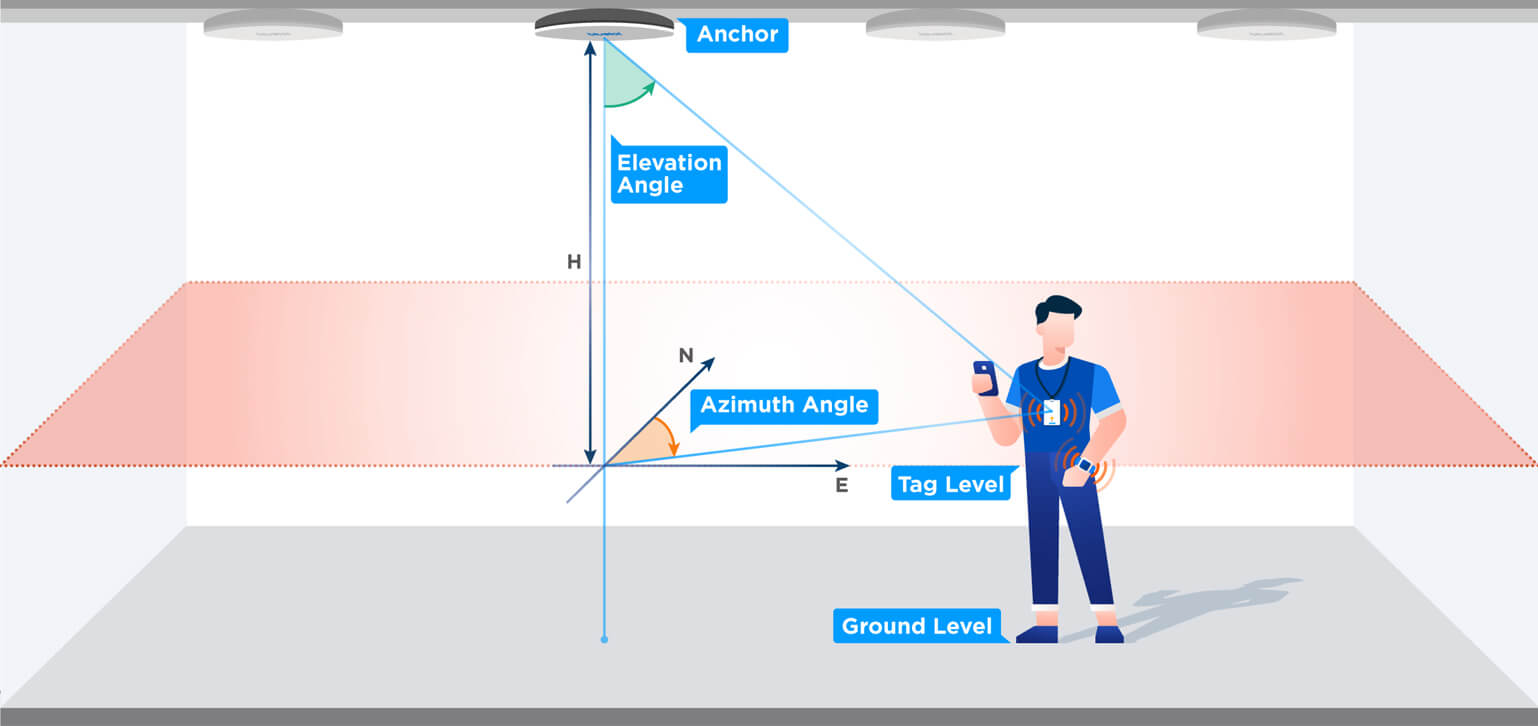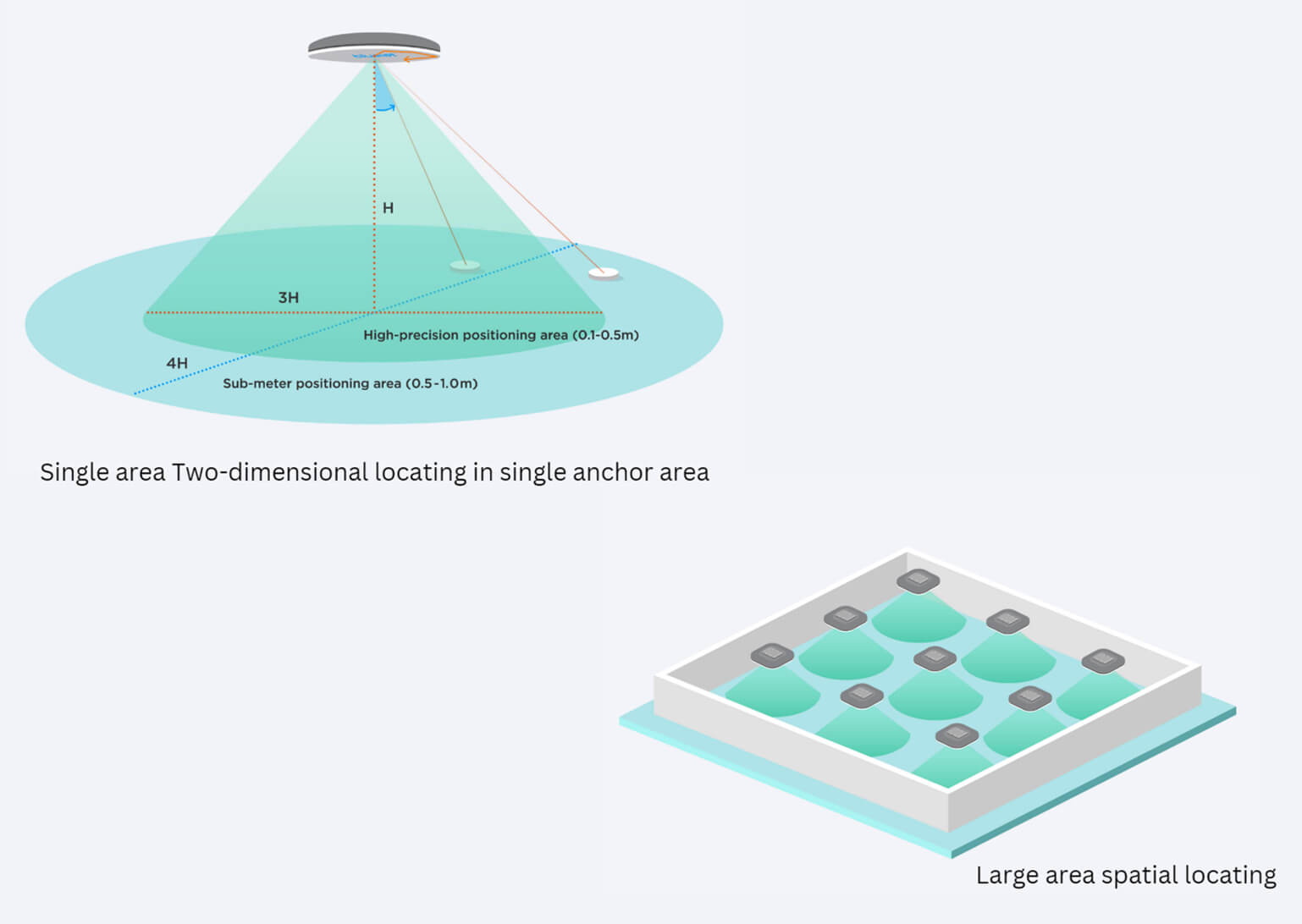Bluetooth technology is a short-range wireless technology that operates in frequencies between 2.4 and 2.485 gigahertz. It was developed by the Bluetooth Special Interest Group (SIG) in 1998 and is now used in various applications. Before the standard was developed, there were some fragmented efforts aimed at naming and establishing it. Initially, Intel called its technology “Biz-RF”, while Ericsson called its mechanism “MC-Link”, and Nokia used the term “Low Power-RF”. Eventually, longtime Intel engineer Jim Kardach proposed that the name Bluetooth be used temporarily.
Since its introduction, Bluetooth technology has undergone several iterations, with each version introducing new features, improvements, and advancements. Among different types of Bluetooth technologies, AoA technology shines with its unique features.
Working Principle of AoA Location:
The Angle of Arrival (AoA) technology is used to determine the direction of a device, such as a tag in a Real-Time Location System (RTLS) solution. The device transmits a direction-finding signal using a single antenna, while the receiving device has multiple antennas arranged in an array.
As the signal crosses the array, the receiving device detects a phase difference due to the distance from each antenna to the transmitting antenna. The machine then calculates the relative signal direction based on the sample data, allowing for precise location tracking. This technology is commonly used in proximity solutions and RTLS for item finding and point-of-interest services.

The Structure of AoA Positioning System?
The Angle of Arrival (AoA) positioning system’s structure typically includes anchors or reference points, each with an antenna, one or more tags or devices, each with a single antenna. The tags transmit a direction-finding signal, which the anchors receive and use the phase differences between the antennas in their respective arrays to determine the direction of each title.
The system can calculate the tags’ positions by knowing the distance between each tag and at least three anchors. The system requires accurate time synchronization between the anchors and tags to accurately calculate the phase differences and determine the direction of the tag. The number of anchors needed depends on the deployment area’s size and complexity and the system’s desired accuracy.
There are primarily two types of Angle of Arrival (AoA) positioning systems:
● Single Anchor AoA Positioning System:
In a single anchor AoA positioning system, one anchor or reference point with an antenna array and one tag or device transmit a direction-finding signal using a single antenna. The anchor receives the signal and uses the phase differences between the antennas in the array to determine the direction of the tag. The system can calculate the tag’s position by knowing the distance between the anchor and the title.
● Single Anchor AoA Positioning System:
A multi-anchor AoA positioning system has multiple anchors or reference points, each with its antenna array and one or more tags or devices, transmitting a direction-finding signal using a single antenna.
The anchors receive the calls and use the phase differences between the antennas in their respective arrays to determine the direction of each tag. The system can calculate the tags’ positions by knowing the distance between each tag and at least three anchors.
Three Applications of AoA Technology
1. Smart Building: AoA technology can enable indoor positioning and wayfinding in intelligent buildings. The system can accurately determine users’ location in real time by deploying multiple anchors with antenna arrays throughout a building, and equipping users with tags that transmit direction-finding signals. This can be used to guide people to their desired locations, track the flow of people throughout the building, and optimize building management processes, such as heating, ventilation, and lighting.
2. Smart Industry: AoA technology can be applied in the intelligent industry to improve asset tracking and inventory management. By attaching tags to assets, such as equipment or tools, and deploying anchors with antenna arrays throughout a facility, the system can determine the precise location of each purchase in real-time. This can track asset utilization, optimize inventory levels, and improve operational efficiency.
3. Smart City: AoA technology can be used in smart cities to enable location-based services and improve public safety. By deploying anchors with antenna arrays throughout a town and equipping users with tags that transmit direction-finding signals, the system can accurately determine users’ location and provide them with location-based information and services, such as directions, information about nearby points of interest, and real-time updates on public transportation. It can also enhance public safety by enabling real-time tracking of emergency responders and facilitating rapid response to emergencies.
Benefits of Blueiot’s AoA Technology
Bluetooth AoA technology is a positioning algorithm that utilizes the Angle of Arrival method to determine the incoming wave’s unique direction and the tag’s position. Blueiot’s Bluetooth 5.1 AoA technology is backward compatible with all Bluetooth 4.0 or above tags and supports high-precision locating services for both BLE AoA tags.
Here are some benefits of Blueiot's AoA technology:
l High accuracy: With an accuracy of 0.1 meters, Blueiot’s AoA technology improves the accuracy of traditional low-precision Bluetooth by ten times.
l High compatibility: Blueiot’s locating anchor is compatible with all Bluetooth 4.0 or above tags, making it easy to integrate with existing systems.
l Low energy consumption: Bluetooth Low Energy technology is used, which reduces the system's energy consumption.
l Multi-dimensional locating: Blueiot’s AoA technology can be used for single-area two-dimensional locating in a single anchor area and large-area spatial locating using multiple anchors.
l Real-time tracking and monitoring: Blueiot’s system can be used for real-time tracking and monitoring of people, assets, and vehicles.
l Versatile applications: The Blueiot AoA system can be used for various applications, including location mapping, trajectory tracing, geo-fencing and alarm, camera linkage, roll call, attendance and work hour statistics, and patrol task management.

The Future of AoA Technology
Here are some trends in AoA technology:
l Larger Bluetooth ecosystem: The AoA technology is expected to become more widely adopted in the Bluetooth ecosystem as the technology continues to evolve. This will lead to developing more devices and applications that use AoA technology, further expanding its reach and utility.
l Optimized technology: As AoA technology becomes more widely used, it will focus on optimizing the technology to improve its accuracy and reliability. This may involve developing new algorithms or refining existing ones to detect better and analyze signals, as well as improving hardware components to enhance the performance of the technology.
l More comprehensive applications: AoA technology is currently used in various applications, including intelligent buildings, smart cities, and innovative industries. As technology advances, it is expected to be applied in more areas, such as healthcare, logistics, and transportation. This will help to improve further efficiency, safety, and productivity in these industries.
About Blueiot
Blueiot is a global leader in location-based services, providing real-time locating systems based on Bluetooth Angle-of-Arrival (AoA) technology. Its indoor tracking system boasts an impressive accuracy of up to 0.1 meters, ten times higher than traditional Bluetooth technology. Blueiot’s innovative indoor positioning system has been widely adopted in various industries, including manufacturing, healthcare, logistics, warehouse management, smart retail, and intelligent buildings.
Blueiot’s open positioning platform offers a flexible and customizable solution that can adapt to different industries’ specific needs. Its innovative solutions have enabled businesses to improve operations and enhance customer experiences.
If you’re looking for an accurate, reliable, and flexible indoor positioning system, Blueiot is worth considering.